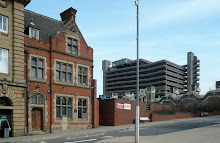| |
| | |
Image: Eric Bainbridge, Late 90's Constructions, Installation view Workplace London. Photo: Wig Worland Eric BainbridgeLate 90's Constructionshttp://www.workplacegallery.co.uk/exhibitions/_60/
8th August - 4th October 2014
Workplace London 61 Conduit Street London W1S 2GB Friday and Saturday, 10am - 6pm (and by appointment) contact: karen@workplacegallery.co.uk tel: 44 (0)207 434 1985
'Late 90's Constructions' brings together a body of works made by Bainbridge in 1997 that specifically address the history of Modernism and the traditional material hierarchies of Modernist Sculpture. In these works Bainbridge employs ubiquitous 'low - grade' materials such as melamine faced chipboard and dental floss to reappraise a Formalist vocabulary. That a material can be 'second - hand' and in some way dirtied and devalued by its former use - yet be explored for its aesthetic potential nevertheless, sits at odds with the Modernist ideal of 'truth to materials' and the inevitable distillation of form and material towards a refined 'pure' essence. In contrast to this reductivist impetus Bainbridge emphasises the 'subordinate' conditions of temporal normality, liberating the autonomous Art object via the absurd patina of everyday life.
'...the small scale of these sculptures allows for various references - constructivism, architecture, the amateur 'string picture', the still life etc. Although I don't consider them as maquettes, the size of the work enables an active imaginative relationship to the object, i.e. it is easy to fantasize about their potential large scale and environmental potential. I wanted to continue exploring the aesthetic, status, and value of the material by using a language that was recognizably modernist. It seemed important that the works 'belonged' to something historical. I like the idea* that if all things were destroyed and we had to remake the contents of museums without "special" materials maybe we would use melamine and dental floss...' Eric Bainbridge, 2014
Eric Bainbridge was born in Consett, County Durham, UK in 1955. He completed a Masters in Sculpture at the Royal College of Art, London in 1981. Frequently cited as one of the most influential British artists working in contemporary sculpture Bainbridge has exhibited in important group exhibitions throughout his career such as "Material Culture" at the Hayward Gallery, London, and "British Art of the 80's and 90's" at IMMA in Dublin, he was recently included in "Modern British Sculpture" at the Royal Academy, London. Solo exhibitions include "View Points" The Walker Art Centre, Minneapolis, "Eric Bainbridge" at The ICA Boston, "Style, Space, Elegance" at The Stedelijk Museum, Amsterdam and recently 'Forward Thinking' at MIMA, Middlesbrough and 'Steel Sculptures' at Camden Art Centre. Bainbridge's work is in significant international collections including the Stedelijk Collection, Arts Council England Collection and the Tate Collection. Bainbridge lives and works in Sunderland, Hartlepool and London.
* from 'Mastering The Art of Ventriloquism' an essay by Penelope Curtis in 'Eric Bainbridge: Works 1991 - 1997, Cornerhouse - Delfina' published by Cornerhouse Press, ISBN 0 948797 48 7
Forthcoming exhibitions include Eric Bainbridge, Workplace Gateshead, 20th September - 25th October 2014. Workplace will be presenting a solo booth of Eric Bainbridge at Frieze Art Fair, Regent's Park, London, 15th - 18th October 2014 (Booth H10) http://friezelondon.com
|











